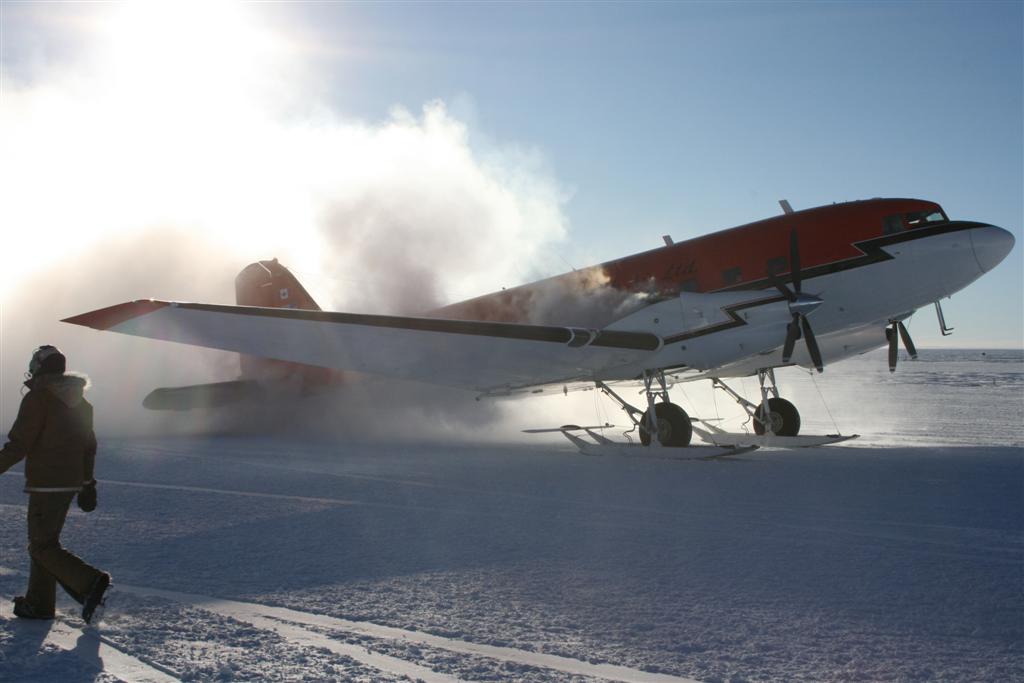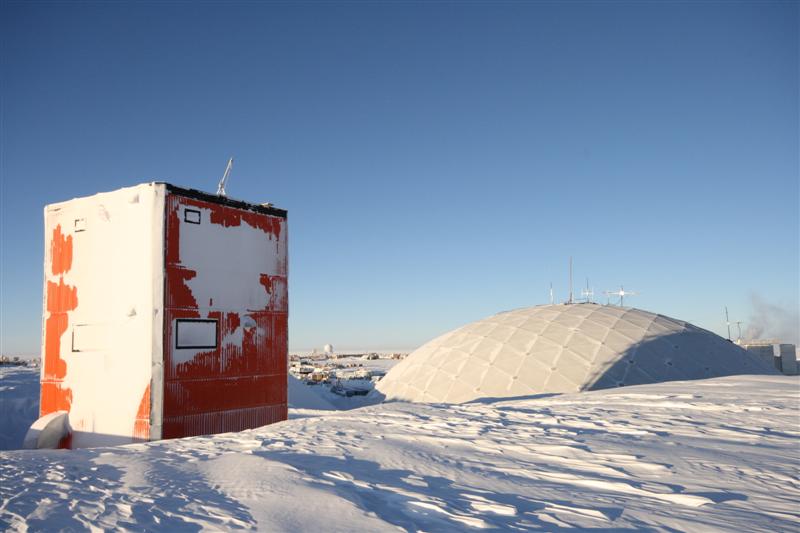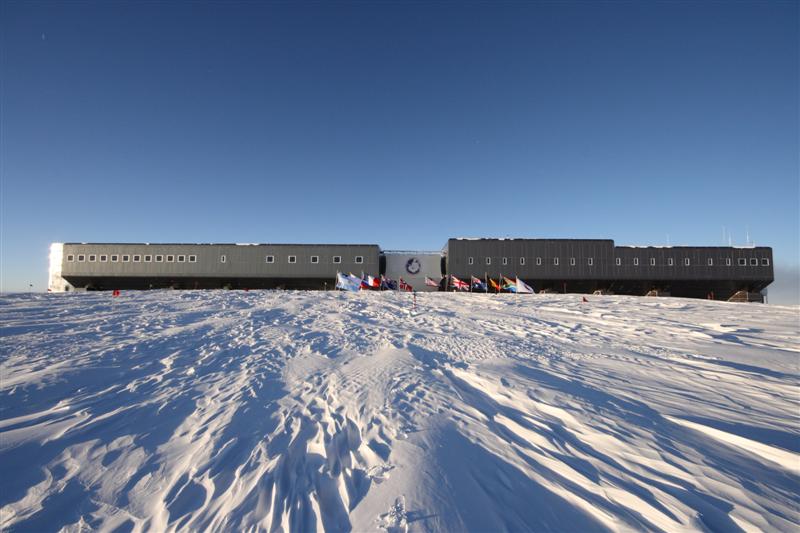October,
2008....J.
Dana Hrubes...updated October 31, 2008 , 2009 GMT
(CLICK ON UNDERLINED
LINKS FOR
PHOTOS....CLICK
"BACK" ON YOUR BROWSER TO RETURN TO THIS PAGE)


At the end of October the first aircraft at the South Pole Since February 14th:
a ski-equipped Basler DC-3 (C-47) lands at the geographic South Pole
October is the month that marks the end of the year spent living and
working at the South Pole and brings the anticipation of returning to
Christchurch in mid-November to lay in the sun at the botanical gardens and catch up sleep.
It is also a month when our busy work schedule gets even busier with
the
addition of end of season reports, finishing up winter tasking, station
opening tasks as well as 24 hour operation of South Pole Telescope (SPT).
A new technical paper was just released by the SPT team with results from this year's data. http://arxiv.org/abs/0810.1578
One of the end of winter task is to groom a new two-mile-long skiway.
This take heavy equipment and a couple of weeks of long days.
Josiah grooming the skiway at -70 degrees F grooming the skiway grooming LMC at SPT
dragging the dark sector The first aircraft since February 14th also arrived at
the end of October. It was a 16 passenger upgraded Basler DC-3. It has
started flying in summer personnel from McMurdo Station on the Coast of
Antarctica some 800 miles away on the other side of the Trans-Antarctic
mountain range. Basler DC-3 refueling at Pole winter polies getting a glimpse of a new strange face DC-3 taking off over the new station Basler DC-3 at flight line DC-3 and disembarking passengers
Once about 30 new people came in we had our winterover ceremony, where
winterovers receive their congressional medals. This year, however, I
got a big surprise when I was presented the National Science Foundation
Polar Programs flag that had been flying over the station all year.
This is the first year that this presentation has been made to the
station science leader. I was a great honor to get this flag and it as
extremely tattered from the harsh winter. NSF flag and SPT NSF flag
 A sad sight: The now dormant dome and a cold skylab are now being quickly buried
A sad sight: The now dormant dome and a cold skylab are now being quickly buried
in snow awaiting an eventual disassembly and shipment back to the States. I spent
three years of my life in these iconic facilities
Speaking of the past, I walked over
to my old SETI telescope tower and service building that have been
decommissioned. It was sad to see the now empty telescope tower and the
drifted in service building where I spent many hours during two winters
operating, troubleshooting and repairing this extra-solar planet
finding optical telescope. AASTO-SETI tower and building

The new elevated station, commissioned in January, 2008 after its first official winter
Dave, the science machinist, left early on the first flight so we took some photos. dave and I with SPT in the background frosty in the middle of nowhere nowhere-part 2 snow accumulation on the dark sector lab where I work and the station a mile away
This month I had to troubleshoot a problem with one of our pulse tube
helium compressors. It would not start. Once I increased the
ultra-high-purity helium in the compressor it started, but I still had
to assemble the compressor with the pulse tube, the pulse tube motor
and the long 66 ft helium lines to give it a full check out run.
Pumping and purging all helium lines and subsystems is critical to
maintaining an extremely high purity of helium in the components. Any
contamination of gases other than helium, such as oxygen or nitrogen in
the system will result in degradation of cooling performance because
these contaminant gases will freeze out on the cold head at these low
temperatures of 2 to 4 degrees C above absolute zero. holding helium pulse tube connecting vacuum turbo pump assembling pulse tube system assembling pulse tube system-2 connecting helium lines to helium compressor pulse tube getting cold
The Federal Aviation Administration made a flight over the Pole this month. FAA flight over the Pole FAA jet and South Pole Telescope
On a final note, Martin Pomerantz, the father of South Pole Astronomy just passed away.
The Martin A Pomerantz Observatory (MAPO) in the dark sector was named in his
honor some years ago. He
wrote a book, Astronomy on Ice - Observing the Universe from the South Pole,
which is published by The American Polar Society (http://www.ampolarsociety.org/index.html) He was director of the Bartol Research Institute, now at the University of Delaware.
Martin A. Pomerantz, December 17,
1916 to October 25, 2008.
For more information see:
http://en.wikipedia.org/wiki/Martin_A._Pomerantz
A Real-Time Photo of South Pole Station as Seen
from the ARO
Building (live when satellite is up)
A
Comprehensive
South Pole Web Site by Bill Spindler
Winterover
Web
Pages
(Bill Spindler's List)
MY
SOUTH
POLE 2007-08 HOME PAGE
MY BI-POLAR HOME PAGE

